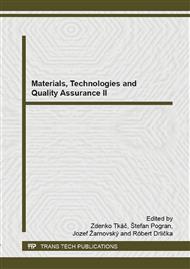[1]
P. Blaškovič, J. Balla, M. Dzimko, Tribológia (Tribology), 1st ed., ALFA, Bratislava, (1990).
Google Scholar
[2]
P. Čičo, M. Bujna, Odolnosť tvrdonávarových materiálov v prevádzkových podmienkach (Resistance of hard-facing materials in operating conditions), 1st ed., Slovak University of Agriculture in Nitra, Nitra, (2011).
Google Scholar
[3]
M. Müller, P. Hrabě, Overlay materials used for increasing lifetime of machine parts working under conditions of intensive abrasion, Res. Agr. Eng., 59 (2013) 16–22.
DOI: 10.17221/64/2011-rae
Google Scholar
[4]
O. Knotek, Thermal spraying and detonation gun processes, in: R. F. Bunshah et al. (Eds. ), Handbook of Hard Coatings. Deposition Technologies, Properties and Applications, Noyes Publications, Park Ridge, 2001, p.77–107.
Google Scholar
[5]
P. Blaškovitš, M. Čomaj, Renovácia naváraním a žiarovým striekaním (Renovation by hard-facing and thermal spraying), 1st ed., Slovak University of Technology, Bratislava, (2005).
Google Scholar
[6]
J. Jasenák, Technologické aspekty spevňovania niklových návarov (Technological aspects of nickel hard-facing reinforcement), 1st ed., AlumniPress, Trnava, (2005).
Google Scholar
[7]
R. Chotěborský, P. Hrabě, M. Müller, J. Savková, M. Jirka, Abrasive wear of high chromium Fe-Cr-C hardfacing alloys, Res. Agr. Eng., 54 (2008) 192–198.
DOI: 10.17221/1/2008-rae
Google Scholar
[8]
I. Kovaříková, P. Blaškovitš, Abrazívne opotrebenie (Abrasive wear), Strojárstvo, 3 (2007) 62–63.
Google Scholar
[9]
J. Suchánek, V. Kuklík, E. Zdravecká, Abrazívní opotřebení materiálů (Abrasive wear of materials), 1st ed., ČVUT, Praha, (2007).
Google Scholar
[10]
M. Brožek, A. Nováková, R. Mikuš, Study of wear resistance of hard facings using welding powders on the NiCrBSi basis, in: Trends in Agricultural Engineering 2010 (conference proceedings), ČZU, Praha, 2010, p.115–118.
Google Scholar
[11]
M. Kotus, Z. Andrássyová, P. Čičo, J. Fries, P. Hrabě, Analysis of wear resistant weld materials in laboratory conditions, Res. Agr. Eng., 57 (2011) S74–S78.
DOI: 10.17221/56/2010-rae
Google Scholar
[12]
T. Pauliček, M. Kotus, M. Daňko, P. Žúbor, Resistance of hard-facing deposit created by laser surfacing technology, Advanced Materials Research, 801 (2013) 117–122.
DOI: 10.4028/www.scientific.net/amr.801.117
Google Scholar
[13]
R. Mikuš, P. Polák, Určovanie mernej hmotnosti materiálov typu NiCrBSi (Determination of specific density of NiCrBSi materials), in: J. Žarnovský et al. (Eds. ), Kvalita a spoľahlivosť technických systémov (Quality and Reliability of Technical Systems), Slovak University of Agriculture in Nitra, Nitra, 2014, p.273.
Google Scholar
[14]
Information on http: /stellite. com/Portals/0/KMT_Stellite_Alloys_Brochure_FINAL. pdf.
Google Scholar
[15]
Information on http: /www. hoganasthermalspray. com/product. html/powder-choice? category_id=22.
Google Scholar
[16]
Information on http: /www. vuz. sk/vyroba_pm_3_7_3. html.
Google Scholar
[17]
Information on http: /www. svarak. cz/c/cz/plamenopraskove-stavovane-povlaky-a-jejich-vyuziti-v-praxi. htm.
Google Scholar
[18]
M. Mrdak, A. Vencl, M. Cosis, Microstructure and mechanical properties of the Mo-NiCrBSi coating deposited by atmospheric plasma spraying, FME Transactions, 37 (2009) 27–32.
Google Scholar
[19]
M. Mrdak, Microstructure and mechanical properties of nickel-chrome-bor-silicon layers produced by the atmospheric plasma spray process, Vojnotehnički Glasnik/Military Technical Courier, LX(1) (2012) 183–200.
DOI: 10.5937/vojtehg1201183m
Google Scholar
[20]
R. Gonzáles, M. A. García, I. Peñuelas, M. Cadenas, M. del Rocío Fernández, A. Hernández Battez, D. Felgueroso, Microstructural study of NiCrBSi coatings obtained by different processes, Wear, 263 (2007) 619–624.
DOI: 10.1016/j.wear.2007.01.094
Google Scholar
[21]
K. Šimunović, I. Kladarić, D. Krumes, Investigation of substrate microstructure after flame spraying and fusing, Strojárstvo, 50 (2008) 213–220.
Google Scholar
[22]
T. Liyanage, G. Fisher, A. P. Gerlich, Influence of alloy chemistry on microstructure and properties in NiCrBSi overaly coatings deposited by plasma-transferred arc welding (PTAW), Surface and Coatings Technology, 205 (2010) 759–765.
DOI: 10.1016/j.surfcoat.2010.07.095
Google Scholar
[23]
L. Trnková, P. Grgač, Priebeh tuhnutia a vývoj mikroštruktúry tvrdonávarovej zliatiny typu NiCrSiB (Solidification process and microstructure evolution of hardfacing alloy of NiCrSiB type), Materials Science and Technology, 5 (2005) 1–10.
Google Scholar
[24]
I. Hemmati, J. C. Rao, V. Ocelík, J. T. M. De Hosson, Electron microscopy characterization of Ni-Cr-B-Si-C laser deposited coatings, Microscopy and Microanalysis, 19 (2013) 120–131.
DOI: 10.1017/s1431927612013839
Google Scholar


